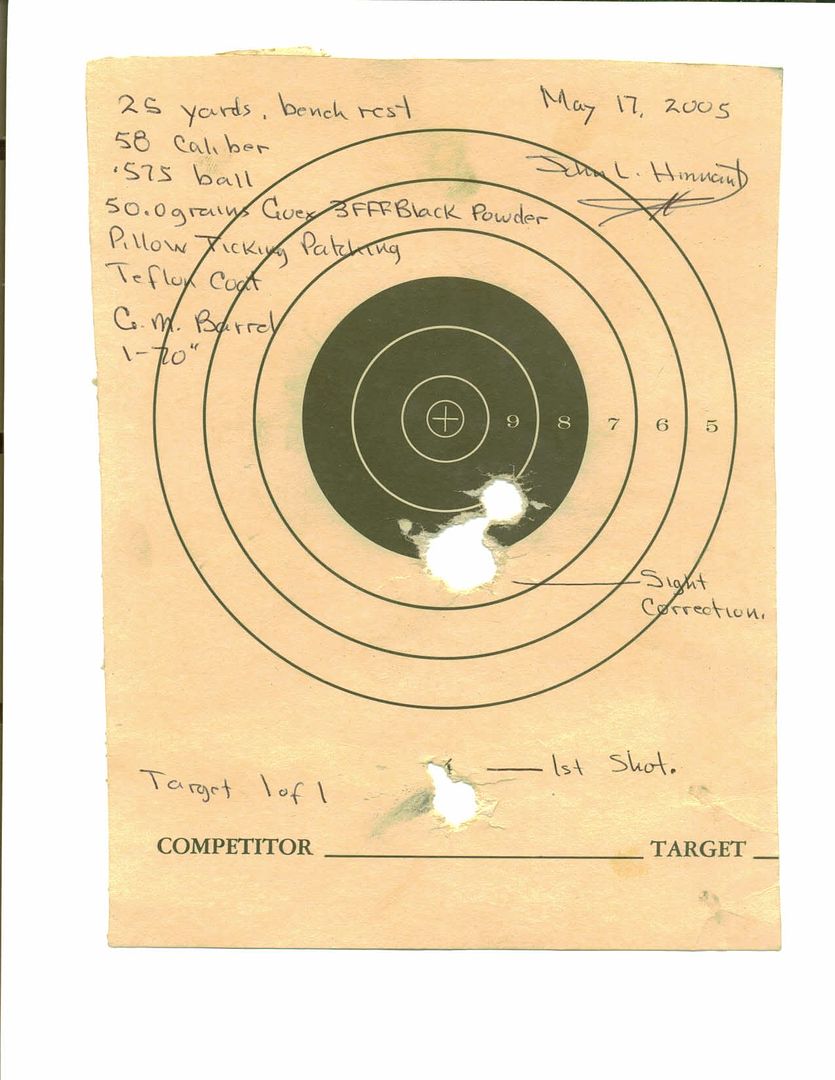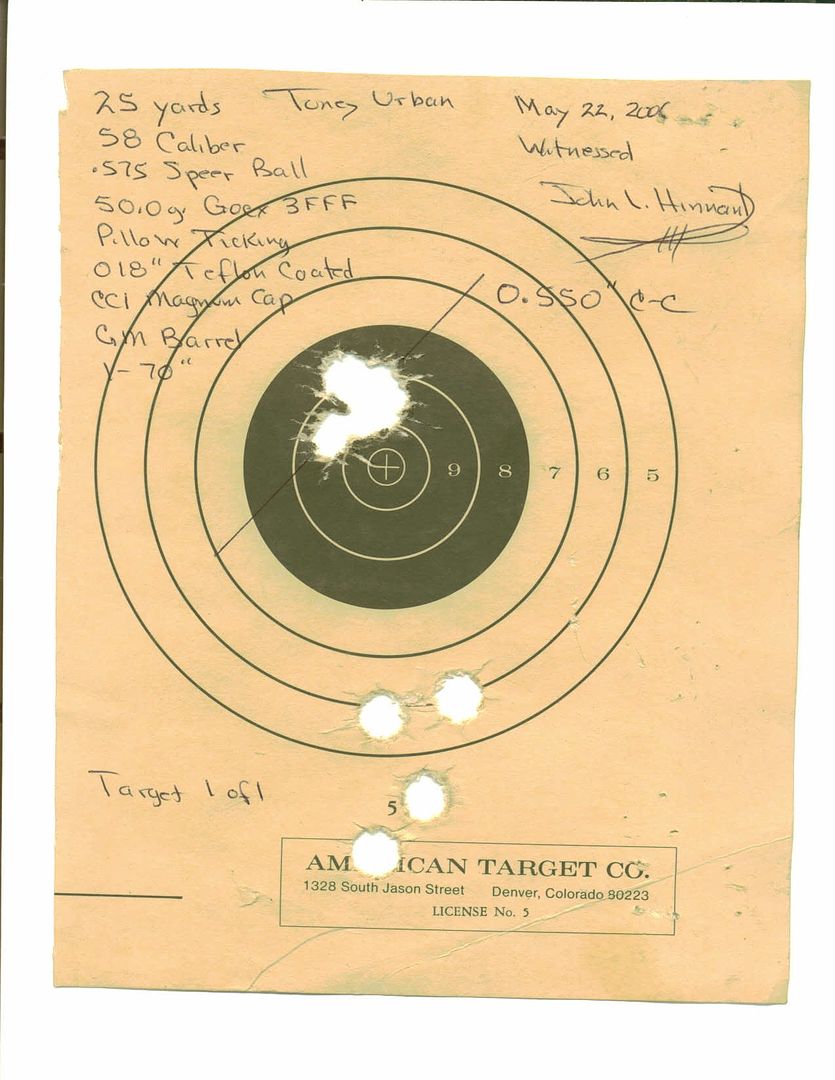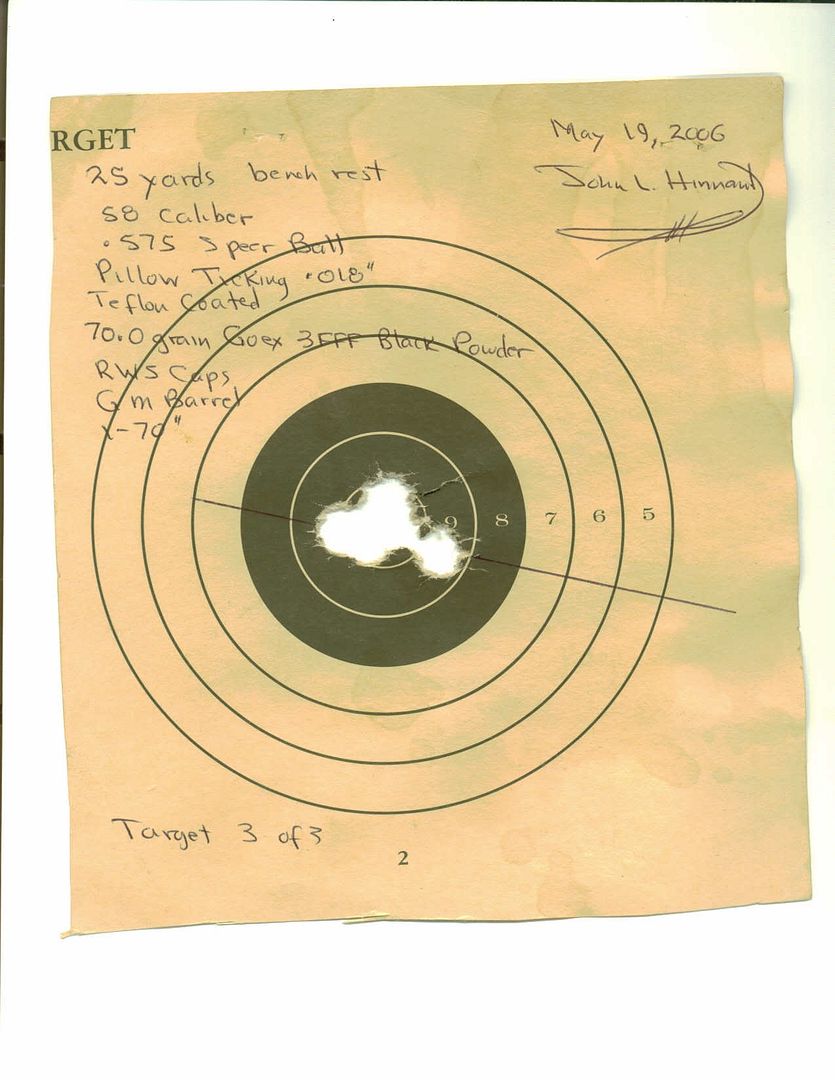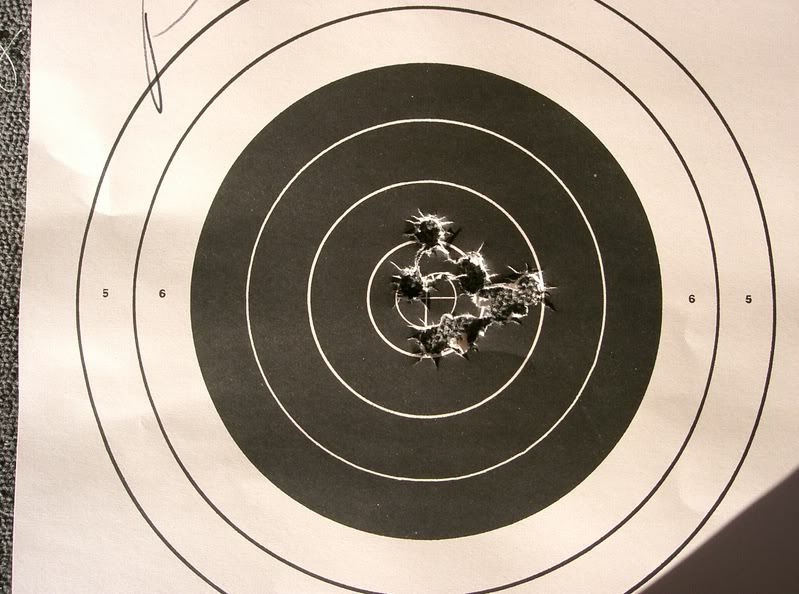Has anyone had success with round balls and relatively fast twist rates? Can you shoot PRB effectively through a 1:48 barrell? If so, do different calibers handle this rate differently? Can an 8 bore handle 1:48 the same as .62, .50? Thanks PJB
-
Friends, our 2nd Amendment rights are always under attack and the NRA has been a constant for decades in helping fight that fight.
We have partnered with the NRA to offer you a discount on membership and Muzzleloading Forum gets a small percentage too of each membership, so you are supporting both the NRA and us.
Use this link to sign up please; https://membership.nra.org/recruiters/join/XR045103
You are using an out of date browser. It may not display this or other websites correctly.
You should upgrade or use an alternative browser.
You should upgrade or use an alternative browser.
Round Ball Twist Rate
- Thread starter pbridges
- Start date

Help Support Muzzleloading Forum:
This site may earn a commission from merchant affiliate
links, including eBay, Amazon, and others.
I think you'll find that a lot of people on here have great success with this twist rate. It may not be able to shoot most accurately with heavy loads, but it's more than sufficient for the hunter. The smaller calibers like 1:48 better, like the .36, but it'll do the job up through .58. I can't say how an 8 bore would like it. An 8 bore? Ouch! :wink:
A twist rate of 1 in 48 is considered a general compromise, supposedly capable of accurately throwing either a patched roundball or a conical projectile. Doesn't matter if the caliber is .32 or .62
However, like most "generalists", this twist rate probably is not the best for either roundball or conical.
With a patched roundball, it is the patch that engages the rifling, not the lead ball. Too fast of a twist and it easy for the patch and ball to simply strip down the bore without any spin.
1 in 66 seems to be a standard twist rate for accuracy with a patched roundball. I have seen some special target barrels with a rate of 1 in 72. Again, caliber doesn't matter. But don't bother with a conical in these barrels. The slow twist is not enough to stabalize the long bullets, and they will likely "keyhole" and fly every-which-way.
However, like most "generalists", this twist rate probably is not the best for either roundball or conical.
With a patched roundball, it is the patch that engages the rifling, not the lead ball. Too fast of a twist and it easy for the patch and ball to simply strip down the bore without any spin.
1 in 66 seems to be a standard twist rate for accuracy with a patched roundball. I have seen some special target barrels with a rate of 1 in 72. Again, caliber doesn't matter. But don't bother with a conical in these barrels. The slow twist is not enough to stabalize the long bullets, and they will likely "keyhole" and fly every-which-way.
1st, twist rates are caliber oriented...and 2nd, it's impossible to make an across the board statement about round ball accuracy in any twist rate until 'accuracy' is defined by the person asking the question or making the statement. Accuracy to a deer hunter may be 2.5"-3" at 100yds but probably not accurate enough for a bullseye shooter in competitions.pjb said:Has anyone had success with round balls and relatively fast twist rates? Can you shoot PRB effectively through a 1:48 barrell? If so, do different calibers handle this rate differently? Can an 8 bore handle 1:48 the same as .62, .50? Thanks PJB
I use the max powder charges in TC's RB load data charts for .45/.50/.54cals, and get that 100 yard accuracy above out of those full power PRB hunting loads from my 1:48" and 1:66" TC barrels and am fine with it...proper fitting patch/ball combinations do not skip rifling in TC's standard 1:48" twist barrels.
And the 1:48" twist is actually THE round ball twist for the .40cal which is often used in competition so you can see, references to 1:48" twist across the board without caliber reference or accuracy definition is impossible to have a simple one-size-fits-all answer.
:thumbsup:
paulvallandigham
Passed On
- Joined
- Jan 9, 2006
- Messages
- 17,537
- Reaction score
- 89
Try multiplying the caliber by 1.2 to get the optimum ROT for a PRB. Here is a list for your convenience:
32 cal. = 38.4
36 cal. = 43.2
40 cal. = 48.0
45 cal. = 54.0
50 cal. = 60.0
54 cal. = 64.8
58 cal. = 60.6
62 cal. = 74.4
69 cal. = 82.8
72 cal. = 86.4
As you can see from this list, most barrel makers are making compromise ROTs for calibers, simply to cut down on the equipement they have to have to do all this. Better reasons, already stated above, is that the PRB can be stablilized fairly well with a compromise ROT. A 1:40 ROT will work for both .32 and .36. You will find 1:48 ROT barrels offered for barrels from .40 cal. through .54, but when you get to the .50 you will find some barrels that are 1:60, and at .54 some barrels that are 1:66. You will also see barrels in both .50 and .54 that a 1:72. Rifled Barrels in the larger bores tend to be in the 1:66- 1:75 inch range.
It is said that you have to use more powder to get higher velocity and stabilization in the slower rates of twist. In actuality, the slower ROT allows you a wider range of powder charges that will NOT send the ball away from your POA.
32 cal. = 38.4
36 cal. = 43.2
40 cal. = 48.0
45 cal. = 54.0
50 cal. = 60.0
54 cal. = 64.8
58 cal. = 60.6
62 cal. = 74.4
69 cal. = 82.8
72 cal. = 86.4
As you can see from this list, most barrel makers are making compromise ROTs for calibers, simply to cut down on the equipement they have to have to do all this. Better reasons, already stated above, is that the PRB can be stablilized fairly well with a compromise ROT. A 1:40 ROT will work for both .32 and .36. You will find 1:48 ROT barrels offered for barrels from .40 cal. through .54, but when you get to the .50 you will find some barrels that are 1:60, and at .54 some barrels that are 1:66. You will also see barrels in both .50 and .54 that a 1:72. Rifled Barrels in the larger bores tend to be in the 1:66- 1:75 inch range.
It is said that you have to use more powder to get higher velocity and stabilization in the slower rates of twist. In actuality, the slower ROT allows you a wider range of powder charges that will NOT send the ball away from your POA.
- Joined
- Oct 19, 2007
- Messages
- 661
- Reaction score
- 398
Paul,
NOT a criticism cause Ive got a "Paul Info" folder that I put all these in..thanks!! but I think the .58 cal ideal ROT would be 69.6 rather than 60.6. Proofreading submitted for those paying attention. "Who put that 0 so danged close to the 9?"
NOT a criticism cause Ive got a "Paul Info" folder that I put all these in..thanks!! but I think the .58 cal ideal ROT would be 69.6 rather than 60.6. Proofreading submitted for those paying attention. "Who put that 0 so danged close to the 9?"
Juggernaut
40 Cal.
- Joined
- Jan 21, 2006
- Messages
- 199
- Reaction score
- 0
I have a Pennsylvania .50 cal flintlock rifle with a 1:66 twist to shoot round balls. I use 15 grains of FFFFg in the primer pan and 120 grains of FFFg as main charge. With a .049 round ball and pillow Ticking .018 patch. I get very tight groupings with this.
Juggernaut
Juggernaut
rabbit03
50 Cal.
- Joined
- Apr 1, 2005
- Messages
- 1,143
- Reaction score
- 17
Paul your correct in this statement :thumbsup:
In actuality, the slower ROT allows you a wider range of powder charges that will NOT send the ball away from your POA.
What John Hinnant and I found out when we shot Big 58 was that no matter how small the powder charge or how large, the balls still grouped in their respective groups. We had clover leafs using 50grns at 25yds and also clover leafs at 25yds using 70grns of 3Fg powder.



Below is a photo of a 100yd target using the same rifle same everything except the charge was 110grns of 2Fg and it was shot off of a X-Stick instead of a sand bag.
Had a bit of left to right that day in Phoenix

rabbit03 :thumbsup:
:grin:
In actuality, the slower ROT allows you a wider range of powder charges that will NOT send the ball away from your POA.
What John Hinnant and I found out when we shot Big 58 was that no matter how small the powder charge or how large, the balls still grouped in their respective groups. We had clover leafs using 50grns at 25yds and also clover leafs at 25yds using 70grns of 3Fg powder.



Below is a photo of a 100yd target using the same rifle same everything except the charge was 110grns of 2Fg and it was shot off of a X-Stick instead of a sand bag.
Had a bit of left to right that day in Phoenix

rabbit03 :thumbsup:
:grin:
Bill Bryan
40 Cal.
I shoot relatively low power loads at targets out to 100 yards. I find that 25 - 30 grains work well in a 1:30 twist barrel in my .50 cal flintlock.
Blizzard of '93
Cannon
- Joined
- Oct 3, 2006
- Messages
- 7,237
- Reaction score
- 14
very impressive shooting :thumbsup:
paulvallandigham
Passed On
- Joined
- Jan 9, 2006
- Messages
- 17,537
- Reaction score
- 89
Thanks for catching that typo, Doc. I wish I were perfect, but they crucified the last guy who tried, and I don't want to go through all that! :thumbsup:
paulvallandigham
Passed On
- Joined
- Jan 9, 2006
- Messages
- 17,537
- Reaction score
- 89
Juggernaut said:I have a Pennsylvania .50 cal flintlock rifle with a 1:66 twist to shoot round balls. I use 15 grains of FFFFg in the primer pan and 120 grains of FFFg as main charge. With a .049 round ball and pillow Ticking .018 patch. I get very tight groupings with this.
Juggernaut
Juggernaut: I have no doubt that you can fire that load in the gun. I believe Davenport's formula works best using FFg powder, but I can't find anyone who knows for sure what he intended, other than it was limited to PRB. The real question is " Why " to shoot such a load? Here, you need to use a chronograph to figure out that while you can fire such a load, you can also get the same accuracy using much less power, and not lose much by way of velocity. I have repeated found, testing different length barrels, and different calibers, that when you exceed the Maximum suggest powder charge, even when you are shooting a slow ROT barrel, that you can see with each 10 grain increment in powder charge that the gain in velocity for that increment keeps dropping off. There is always some gain, however small. But, when the gain gets down to the shot to shot variation for that load combination it makes no sense at all to continue to add more powder. When you then consider the horrible Ballistic's Coefficient of round balls, and understand how quickly all that little extra velocity is lost, typically within the first 25 yards, using more powder than what the barrel can efficiently burn makes even less sense.
Its your gun, your wallet, your shoulder, and your freedom to do as you wish. If you want more power shooting round balls, Increase the Bore Diameter of the gun you are shooting. If you want to get greater penetration, use a lead alloy ball, or much better yet, use a conical bullet instead of a round ball. Conicals are appropriate for large boned animals, such as Elk, Moose, Caribou, Bear, and large wild boar. NO doubt about it. A round ball works well on thin skinned animals that weigh up to 300 lbs. You might find a Mule deer so big that you want to use a conical, but that will be the rare trophy buck. Shot placement is more likely going to be the key to bring him down. A guy who practices shooting PRB all the time, and knows his gun is much more likely to hit where he needs his ball to go to kill a deer, no matter what size, than someone who has fired a couple of conicals, to zero the gun's sights, and then heads off to the woods, not having any real idea about what that load will do at various ranges.
Juggernaut
40 Cal.
- Joined
- Jan 21, 2006
- Messages
- 199
- Reaction score
- 0
Paul,
This is the load that I have came up with to be the most accurate. Being the barrel is almost 41 inches long there is sufficient barrel length to burn the powder completely and utilize all the energy. Recoil is minimal due to the long barrel and weight. The extra cost is negligible just a few cents more to zero her in.
Juggernaut
This is the load that I have came up with to be the most accurate. Being the barrel is almost 41 inches long there is sufficient barrel length to burn the powder completely and utilize all the energy. Recoil is minimal due to the long barrel and weight. The extra cost is negligible just a few cents more to zero her in.
Juggernaut
paulvallandigham
Passed On
- Joined
- Jan 9, 2006
- Messages
- 17,537
- Reaction score
- 89
Jug: The maximum charge for a 42 inch barrel in .50 caliber is 95 grains. YOu should find a good, accurate load at 85-90 grains, that works efficiently. I am not poor mouthing you by suggesting that you are wasting money. I am just pointing out that fact as one more factor to consider in the load you choose. The difference in recoil for the lower powder charge will be noticeable.
Juggernaut
40 Cal.
- Joined
- Jan 21, 2006
- Messages
- 199
- Reaction score
- 0
Paul,
None taken and I thank you for your advice I have tried those loads and they group 6 inches or better. With the load I'm using now get it down to less the 2 inches.
Juggernaut
None taken and I thank you for your advice I have tried those loads and they group 6 inches or better. With the load I'm using now get it down to less the 2 inches.
Juggernaut
Juggernaut said:Paul,
This is the load that I have came up with to be the most accurate. Being the barrel is almost 41 inches long there is sufficient barrel length to burn the powder completely and utilize all the energy. Recoil is minimal due to the long barrel and weight. The extra cost is negligible just a few cents more to zero her in.
Juggernaut
Jug, its your hobby, your choices, it obviously works, and it brings you satisfaction...that's what hobbies are all about.
:thumbsup:
It would be presumptuous of me...indeed, anybody...to thrust into what you're doing uninvited, and challenge what or why you're doing it...if I...indeed, if anybody...did that it would suggest a know-it-all attitude, sort of a "my way is best", or "my way is the only way" sort of an attitude...just no call for that in our personal hobbies.
Sounds like you have that rifle dialed in right...keep up the good work!
:hatsoff:
Juggernaut
40 Cal.
- Joined
- Jan 21, 2006
- Messages
- 199
- Reaction score
- 0
Roundball,
Thank you. I'm always open to suggestions and willing consider all advice if I think it is sound. I have been doing Black Powder for going on 30 years now. I would say since my High School era in the early 80's. And I’m still eager to learn something new and always willing to hear anyone out. Had I not already tried those loads that were suggested. I would have given them a try? I enjoy this forum for the wealth of information that is available and respect everyone’s opinion.
Juggernaut
Thank you. I'm always open to suggestions and willing consider all advice if I think it is sound. I have been doing Black Powder for going on 30 years now. I would say since my High School era in the early 80's. And I’m still eager to learn something new and always willing to hear anyone out. Had I not already tried those loads that were suggested. I would have given them a try? I enjoy this forum for the wealth of information that is available and respect everyone’s opinion.
Juggernaut
paulvallandigham
Passed On
- Joined
- Jan 9, 2006
- Messages
- 17,537
- Reaction score
- 89
Juggernut: You can shoot anything you want to shoot. But what I am talking about is efficiency of a load.
I looked at my Hodgdon reloading manual which gives a number of loadings for the .50 cal. RB.
I will list the loading data from the book, next to which I will indicate the gain in velocity from each 10 GRain increment of powder. These velocities were made with FFg powder, so Expect your loads, using FFFg powder, will have a greater velocity, but also a greater drop off.
60 gr. FFG ,490 RB 175 Gr. 1390 Velocity
70 gr. FFg .490 RB 175 gr. 1554 + 164fps
80 gr. FFg same same 1729 + 175fps
90 gr. FFg same same 1872 + 143fps
100 gr.FFg same same 1988 + 116fps
Now, the book does not give the length of the barrel used for these tests. I would estimate the barrel length of between 36 and 40 inches long.
Its is clear from the data that the efficiency of adding more powder ends at 80 grains, because at 90 and 100 grains, the increase drops off.
This is the reason I bother you with Maximum burn rates for a given caliber. Cost of powder, the amount of recoil and other reasons mean very little unless we are both shooting the exact same gun. I can't know if your gun has More Felt Recoil with your loads unless I shoot that gun with that load, compared to something I would choose instead. I can't know if my lower powder charge will prove to be as accurate as your load is, unless I were to bench rest the gun and do extensive testing over several days, so as to eliminate as many human and weather related factors from the groups sizes as possible.
What I can observe is that most of the members here who shoot .50 caliber RB for hunting, are using between 70 and 90 grains of powder for their hunting purposes. That is a lot less powder than you are using.
Best wishes, and contiued success. :thumbsup:
I looked at my Hodgdon reloading manual which gives a number of loadings for the .50 cal. RB.
I will list the loading data from the book, next to which I will indicate the gain in velocity from each 10 GRain increment of powder. These velocities were made with FFg powder, so Expect your loads, using FFFg powder, will have a greater velocity, but also a greater drop off.
60 gr. FFG ,490 RB 175 Gr. 1390 Velocity
70 gr. FFg .490 RB 175 gr. 1554 + 164fps
80 gr. FFg same same 1729 + 175fps
90 gr. FFg same same 1872 + 143fps
100 gr.FFg same same 1988 + 116fps
Now, the book does not give the length of the barrel used for these tests. I would estimate the barrel length of between 36 and 40 inches long.
Its is clear from the data that the efficiency of adding more powder ends at 80 grains, because at 90 and 100 grains, the increase drops off.
This is the reason I bother you with Maximum burn rates for a given caliber. Cost of powder, the amount of recoil and other reasons mean very little unless we are both shooting the exact same gun. I can't know if your gun has More Felt Recoil with your loads unless I shoot that gun with that load, compared to something I would choose instead. I can't know if my lower powder charge will prove to be as accurate as your load is, unless I were to bench rest the gun and do extensive testing over several days, so as to eliminate as many human and weather related factors from the groups sizes as possible.
What I can observe is that most of the members here who shoot .50 caliber RB for hunting, are using between 70 and 90 grains of powder for their hunting purposes. That is a lot less powder than you are using.
Best wishes, and contiued success. :thumbsup:
Newtire
32 Cal.
- Joined
- Oct 25, 2009
- Messages
- 635
- Reaction score
- 498
I think a 1-48” is a little fast for anything much bigger than .45 for real fine accuracy T/C made their “Hawken” .50 with a 1-48” twist and it did OK with round balls but a slow twist Green Mountain barrel drop in shrinks the group. That slow twist Green Mountain doesn’t shoot a Maxi Ball worth anything but the T/C 1-48 does an OK job. The smaller the bore, the faster the twist for good performance. A slow for the caliber in a .32 caliber will shoot a round ball great with a heavier powder charge.A twist rate of 1 in 48 is considered a general compromise, supposedly capable of accurately throwing either a patched roundball or a conical projectile. Doesn't matter if the caliber is .32 or .62
However, like most "generalists", this twist rate probably is not the best for either roundball or conical.
With a patched roundball, it is the patch that engages the rifling, not the lead ball. Too fast of a twist and it easy for the patch and ball to simply strip down the bore without any spin.
1 in 66 seems to be a standard twist rate for accuracy with a patched roundball. I have seen some special target barrels with a rate of 1 in 72. Again, caliber doesn't matter. But don't bother with a conical in these barrels. The slow twist is not enough to stabalize the long bullets, and they will likely "keyhole" and fly every-which-way.
Similar threads
- Replies
- 5
- Views
- 419
- Replies
- 14
- Views
- 615




